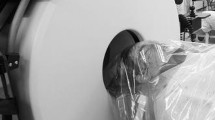Abstract
Purpose
To compare the sequence bottom-up inside-out with top-down outside-in, in the treatment of pan facial fractures and to evaluate the outcome of these approaches.
Patients and Methods
The data from 11 patients with panfacial fracture are prospectively analysed. Five cases are treated with bottom-up approach and six patients with top-down approach.
Results
There were 11 male patients (six in top-down approach and five in bottom-up approach), ranging in age from 24 to 50 years. All injuries were result of RTA (n = 11, 100 %). Final treatment outcome was excellent in 3 (50 %), 1 (16 %) good and 2 (32 %) cases were fair in topdown approach, 3 (60 %) excellent and 2 (40 %) fair in bottom up approach with contingency coefficient value (P < .632) which was insignificant. There was no significant deviation from the two groups in the final treatment outcome.
Conclusion
Within the limitation of low sample size we found that both bottom-up inside-out and top-down outside-in approaches have similar clinical outcomes. Hence it could be suggestive to start fixation of least disrupted (more stable) facial half as a guide for reconstruction of the remaining. Choice of the bottom-up inside-out or top-down outside-in sequence should be according to the pattern of fractures and preference of the surgeon. However, further controlled clinical trials, comparative studies with a larger sample size would be better to evaluate the final clinical outcome of individual techniques.











Similar content being viewed by others
References
Wenig BL (1991) Management of panfacial fractures. Otolaryngol Clin N Am 24:93
Manson PN, Clark N (1999) Subunit principles in midface fractures: the importance of sagittal buttresses, soft-tissue reductions, and sequencing treatment of segmental fractures. Plast Reconstr Surg 103(4):1287–1307
Sawhney CP, Ahuja RB (1988) Faciomaxillary fractures in North India: a statistical analysis and review of management. Br J Oral Maxillofac Surg 26(5):430
William Curtis W, Horswell BB (2013) Panfacial fractures: an approach to management. Oral Maxillofac Surg Clin N Am 25(2013):649–660
McGraw-Wall B (2005) Sequencing of facial fracture repair. In: Stewart MG (ed) Head, face, and neck trauma: comprehensive management, chap 15. Thieme publishers, New York pp 142–149
Pau M, Reinbacher KE (2014) The mandibular symphysis as a starting point for the occlusal-level reconstruction of panfacial fractures with bicondylar fractures and interruption of the maxillary and mandibular arches: report of two cases. J Cranio Maxillo Fac Surg 42:e51–e56
Gruss JS (1992) Craniofacial fractures: an algorithm to optimize results. Clin Plast Surg 19:195–206
Tullio A, Sesenna E (2000) Role of surgical reduction of condylar fractures in the management of pan facial fractures. Br J Oral Maxillofac Surg 38:472–476
Yang R, Zhang C, Liu Y (2012) Why should we start from mandibular fractures in the treatment of pan facial fractures? J Oral Maxillofac Surg. doi:10.1016/j.joms.2011.11.006
Louis PJ (2004) Management of pan facial fractures. In: Miloro M (ed) Peterson’s principles of oral and maxillofacial surgery, chap 28, vol l, 2nd edn. BC Decker Inc, Hamilton pp 547–559
Markowitz BL, Manson PN (1989) Panfacial fractures: organization of treatment. Clin Plast Surg 16(1):105–114
He D, Zhang Y, Ellis E (2007) Pan facial fracture: analysis of 33 cases treated late. J Oral Maxillofac Surg. doi:10.1016/j.joms.2007.06.625
Carr RM, Mathog RH (1997) Early and delayed repair of orbitozygomatic complex fractures. J Oral Maxillofac Surg 55:253
Ellis III E, Throckmorton G (2000) Facial symmetry after closed and open treatment of fractures of the mandibular condylar process. J Oral Maxillofac Surg 58:719–728
O’Connell J, Murphy C (2009) The fate of titanium miniplates and screws used in maxillofacial surgery: a 10 year retrospective study. Int J Oral Maxillofac Surg 38:731–735
Author information
Authors and Affiliations
Corresponding author
Rights and permissions
About this article
Cite this article
Degala, S., Sundar, S.S. & Mamata, K.S. A Comparative Prospective Study of Two Different Treatment Sequences i.e. Bottom Up–Inside Out and Topdown–Outside in, in the Treatment of Panfacial Fractures. J. Maxillofac. Oral Surg. 14, 986–994 (2015). https://doi.org/10.1007/s12663-015-0769-2
Received:
Accepted:
Published:
Issue Date:
DOI: https://doi.org/10.1007/s12663-015-0769-2




